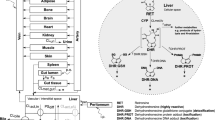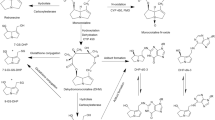Abstract
Our study was performed in the context of an in vitro primary hepatic cell culture as an alternative for the in vivo cancerogenic bioassay. The 29 substances which are to be used in the in vitro primary hepatic cell culture have been tested in 2-year bioassays and a 14-day short term study. The aim of this modelling study was to simulate the concentration–time profile of the compounds when given by the oral route at the doses tested in the previous studies taking into account the percentage of the dose absorbed. The model contained seven tissue compartments with uptake from the gastrointestinal tract into the portal vein. Because the primary hepatic cell culture is metabolically competent and the primary interest was to model the concentration in the portal vein, the hepatic vein and the systemic circulation (blood) in the beginning we did not include elimination. Partitioning between blood and tissues was calculated according to a published biologically based algorithm. The substances’ kinetic profile differed according to their blood: tissue partitioning. Maximal concentrations in portal vein, hepatic vein and the blood depended mainly on the dose and the fraction absorbed which were the most critical parameters in this respect. Our study demonstrates an application of BPTK modelling for the purpose to simulate concentrations for planning the doses for an in vitro study. BPTK modelling seems to be a better approach than using data from in vitro studies on cytotoxicity.


Similar content being viewed by others
References
Allen DG, Pearse G, Haseman JK, Maronpot RR (2004) Prediction of rodent carcinogenesis: an evaluation of prechronic liver lesions as forecasters of liver tumors in NTP carcinogenicity studies. Toxicol Pathol 32:393–401
Barratt MD, Castell JV, Chamberlain M, Combes RD, Dearden JC, Fentem JH, Gerner I, Giuliani A, Gray TJB, Livingstone DJ, Provan WML, Rutten F, Verhaar HJM, Zbinden P (1995) The integrated use of alternative approaches for predicting toxic hazard––the report and recommendations of ECVAM workshop-8. ATLA-Altern Lab Anim 23:410–429
Benevenga NJ, Steele RD (1984) Adverse effects of excessive consumption of amino acids. Annu Rev Nutr 4:157–181
Bitsch A, Hadjiolov N, Klöhn P-C, Bergmann O, Zwirner-Baier I, Neumann G (2000) Dose response of early effects related to tumor promotion of 2-acetylaminofluorene. Toxicol Sci 50:44–51
Blaauboer BJ (2010) Biokinetic modelling and in vitro-in vivo extrapolations. J Toxicol Environ Health B 13:242–252
Blaauboer BJ, Bayliss MK, Castell JV, Evelo CTA, Frazier JM, Groen K, Gülden M, Guillouzo A, Hissink AM, Houston BJ, Johanson G, de Jongh J, Kedderis GL, Reinhardt CA, van de Sandt JJM, Semino G (1996) The use of biokinetics and in vitro methods in toxicological risk evaluation. ATLA-Altern Lab Anim 24:473–497
Bouvier d’Yoire M, Prieto P, Blaauboer BJ, Bois FY, Boobis A, Brochot C, Coecke S, Freidig A, Gundert-Remy U, Hartung T, Jacobs MN, Lavé T, Leahy DE, Lennernäs H, Loizou GD, Meek B, Pease C, Rowland M, Spendiff M, Yang J, Zeilmaker M (2007) Physiologically-based kinetic modelling (pbk modelling): meeting the 3Rs agenda: the report and recommendations of ECVAM workshop 63. ATLA-Altern Lab Anim 35:661–671
Brown RP, Delp MD, Lindstedt SL, Rhomberg LR, Beliles RP (1997) Physiological parameter values for physiologically based pharmacokinetic models. Toxicol Ind Health 13:407–484
Byard J, Needham D (2006) Metabolism and excretion of piperonyl butoxide in the rat. Xenobiotica 36:1259–1272
Calandre EP, Alferez N, Hassanein K, Azarnoff DL (1981) Methapyrilene kinetics and dynamics. Clin Pharmacol Ther 29(4):527–532
ChemSilico (2010) http://www.chemsilico.com. Accessed 15 June 2010
ChemSpider (2010) http://www.chemspider.com. Accessed 15 June 2010
Chilakapati J, Shankar K, Korrapati MC, Hill RA, Mehendale HM (2005) Saturation toxicokinetics of thioacetamide: role in initiation of liver injury. Drug Metab Dispos 33:1877–1885
Combes R, Balls M, Illing P, Bhogal N, Dale J, Duve G, Feron V, Grindon C, Gulden M, Loizou G, Priston R, Westmoreland C (2006) Possibilities for a new approach to chemicals risk assessment–the report of a FRAME workshop. ATLA-Altern Lab Anim 34:621–649
Coulombe RA Jr, Sharma RP (1985) Clearance and excretion of intratracheally and orally administered aflatoxin B1 in the rat. Food Chem Toxicol 23:827–830
Davies NM (1998) Clinical pharmacokinetics of ibuprofen: the first 30 years. Clin Pharmacokinet 34:101–154
Davies DS, Wing AM, Reid JL, Neill DM, Tippett P, Dollery CT (1977) Pharmacokinetics and concentration-effect relationships of intravenous and oral clonidine. Clin Pharmacol Ther 21:593–601
DeJongh J, Verhaar HJM, Hermens JLM (1997) A quantitative property-property relationship (QPPR) approach to estimate in vitro tissue-blood partition coefficients of organic chemicals in rats and humans. Arch Toxicol 72:17–25
Divoll M, Greenblatt DJ, Ameer B, Abernethy DR (1982) Effect of food on acetaminophen absorption in young and elderly subjects. J Clin Pharmacol 22:571–576
Drugbank (2010) http://www.drugbank.ca. Accessed 15 June 2010
Ellinger-Ziegelbauer H, Gmuenderb H, Bandenburg A, Ahr HJ (2008) Prediction of a carcinogenic potential of rat hepatocarcinogens using toxicogenomics analysis of short-term in vivo studies. Mutat Res 637:23–39
Evans MV, Andersen ME (2000) Sensitivity analysis of a physiological model for 2, 3, 7, 8-tatrachlorodibenzo-p-dioxin (TCDD): assessing the impact of specific model parameters on sequestration in liver and fat in the rat. Toxicol Sci 54:71–80
Gombar CT, Harrington GW, Pylypiw HM Jr, Anderson LM, Palmer AE, Rice JM, Magee PN, Burak ES (1990) Interspecies scaling of the pharmacokinetics of W-nitrosodimethylamine. Cancer Res 50:4366–4370
Grundy JS, Eliot LA, Foster RT (1997) Biopharm Extrahepatic first-pass metabolism of nifedipine in the rat. Biopharm Drug Dispos 18:509–522
Hobbs DC, Twomey TM, Palmer RF (1978) Pharmacokinetics of prazosin in man. J Clin Pharmacol 18(8–9):402–406
Institut national de recherche et de sécurité (2004) Alcool allylique. Fiche toxicologique no. 156. INRS, Paris
Keldenich J (2009) Measurement and prediction of oral absorption. Chem Biodivers 6:2000–2013
Kennedy GL (1982) Biological effects of acetamid, formaid, and their monomethyl and dimethyl derivatives. Crit Rev Toxicol 17:129–182
Levin VA, Liu J, Weinkam RJ (1981) Comparative pharmacokinetics of 1-(2-Chloroethyl)-3-(2, 6-dioxo-1-piperidyl)-1-nitrosourea in rats and patients and extrapolation to clinical trials. Cancer Res 41:3475–3477
Loizou GD, Spendiff M, Barton HA, Bessems J, Bois FY, Bouvier d’Yvoire M, Buist H, Clewell H III, Gundert-Remy U, Goerlitz G, Meek B, Schmitt W (2008) Development of good modelling practice for physiologically based pharmacokinetic models for use in risk assessment: the first steps. Regul Toxicol Pharmacol 50:400–411
Mielke H, Gundert-Remy U (2009) Bisphenol a levels in blood depend on age and exposure. Toxicol Lett 190:32–40
Mora PC, Cirri M, Guenther S, Allolio B, Carli F, Mura P (2003) Enhancement of dehydroepiandrosterone solubility and bioavailability by ternary complexation with alpha-cyclodextrin and glycine. J Pharm Sci 92(11):2177–2184
Neumann H (1976) Dose-dependent kinetics of diethylstilbestrol in the rat. J Toxicol Environ Health Suppl 1:61–76
Okable H, Higashi T, Ohta T, Hashimoto Y (2004) Intestinal absorption and hepatic extraction of propranolol and metoprolol in rats with bilateral ureteral ligation. Biol Pharm Bull 27(9):1422–1427
Pepping J (2000) DHEA: dehydroepiandrosterone. Am J Health Syst Pharm 57(22):2048–2056
PhysProp Database (2010) http://www.syrres.com. Accessed 15 June 2010
Ramsey JC, Andersen ME (1984) A physiologically based description of the inhalation pharmacokinetics of styrene in rats and humans. Toxicol Appl Pharmacol 73:159–175
Ruiz-Carretero P, Nacher A, Merino-Sanjuan M, Casabo VG (2000) Pharmacokinetics and absolute bioavailability of oral cefuroxime axetil in the rat. Int J Pharm 202(1–2):89–96
Schmitt W (2008) General approach for the calculation of tissue to plasma partition coefficient. Toxicol In Vitro 22:457–467
Schug M, Heise T, Bauer A, Storm D, Blaszkewicz M, Bedawy E, Brulport M, Geppert B, Hermes M, Föllmann W, Rapp K, Maccoux L, Schormann W, Appel KE, Oberemm A, Gundert-Remy U, Hengstler JG (2008) Primary rat hepatocytes as in vitro system for gene expression studies: comparison of sandwich, Matrigel and 2D cultures. Arch Toxicol 82:923–931
Shalaeva M, Kenseth J, Lombardo F, Bastin A (2008) Measurement of dissociation constants (pKa values) of organic compounds by multiplexed capillary electrophoresis using aqueous and cosolvent buffers. J Pharm Sci 97:2581–2606
Speck U, Wendt H, Schulze PE, Jentsch D (1976) Bioavailability and pharmacokinetics of cypreterone acetate-C14 and ethinyloestradiol-3H after oral administration as coated tablet (SH B 209 AB). Contraception 14:151–163
Stewart BW, Magee PN (1972) Metabolism and some biochemical effects of N-nitrosomorpholine. Biochem J 126(3):21P–22P
Verwei M, Freidig AP, Harenaar R, Groten JP (2006) Prediciton of in vivo embryotoxic effect levels with a combination of in vitro studies and PBPK modelling. Toxicol Lett 165:79–87
Wan H, Holmén AG, Wang Y, Lindberg W, Englund M, Någård MB, Thompson RA (2003) High-throughput screening of pKa values of pharmaceuticals by pressure-assisted capillary electrophoresis and mass spectrometry. Rapid Commun Mass Spectrom 23:2639–2648
Zhang X, Tsang AM, Okino MS, Power FW, Knaak JB, Harrison LS, Dary CC (2007) A physiologically based pharmacokinetic/pharmacodynamic model for carbofuran in sprague-dawley rats using the exposure-related dose estimating model. Toxicol Sci 100(2):345–359
Acknowledgments
The authors express their thanks to Walter Schmitt who provided help for the calculation of partition coefficients.
Conflict of Interest
The authors declare that they have no conflict of interest.
Author information
Authors and Affiliations
Corresponding author
Rights and permissions
About this article
Cite this article
Mielke, H., Anger, L.T., Schug, M. et al. A physiologically based toxicokinetic modelling approach to predict relevant concentrations for in vitro testing. Arch Toxicol 85, 555–563 (2011). https://doi.org/10.1007/s00204-010-0612-y
Received:
Accepted:
Published:
Issue Date:
DOI: https://doi.org/10.1007/s00204-010-0612-y




